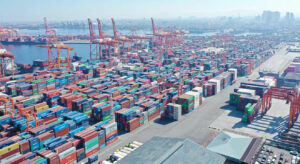June trade gap widens to record $5.8 billion

By Abigail Marie P. Yraola, Researcher
THE Philippines’ merchandise trade deficit hit another record in June as imports continued to outpace exports despite a year-on-year slowdown.
Imports grew by 26% annually to $12.487 billion in June, according to preliminary data from the Philippine Statistics Authority (PSA). This was slower than the revised 30.2% in May and 42.4% in June 2021.
The yearly increase in imports eased to its lowest since the 23.4% jump in March.
June marked the 17th straight month of imports growth.
Meanwhile, exports inched up by 1% to $6.644 billion in June, sharply slower than the revised 6.4% in May and 18.9% in June last year.
This was the slowest annual growth since the 1.4% contraction in February 2021.
This brought the balance of trade in goods — the difference between exports and imports — to a record deficit of $5.843 billion in June.
It was wider than the $3.331-billion gap in the same month last year and the revised $5.556-billion deficit in May.
Meanwhile, total trade — the sum of exports and imports — jumped by 16.1% to $19.131 billion. The growth was slower than the revised 20.8% in May and 32% in June a year ago.
In the first semester of 2022, imports rose by 26.7% to $68.320 billion, above the government’s 18% target for this year.
Exports likewise went up by 7.1% to $38.527 billion, in line with the 7% full-year growth target set by the Development Budget Coordination Committee.
Year to date, the trade balance has ballooned to a $29.793-billion deficit from the $17.953-billion gap a year ago.
Socioeconomic Planning Secretary Arsenio M. Balisacan said the country’s trade deficit is expected to widen this year.
“We are ramping up and continuing the rapid growth in our construction spending for capital formation,” Mr. Balisacan said at a press conference on Tuesday.
UnionBank of the Philippines, Inc. Chief Economist Ruben Carlo O. Asuncion said the trade activity has slowed as it returns to its pre-pandemic level.
“The continued widening of the trade deficit is still mainly due to the bloated imports made up largely of higher oil costs and higher priced imported inputs,” he said in an e-mail.
“Nevertheless, with global oil prices on the decline due mainly to higher supplies, we will see the trade deficit ease in the coming months and therefore easing off pressure on the local currency.”
Security Bank Corp. Chief Economist Robert Dan J. Roces said in an e-mail that global supply chain issues affecting electronic components drove exports lower in June.
“This was exacerbated by the extraordinary level of electronics demand post-pandemic, and as such there is a need to make the electronics manufacturing process resilient to supply chain disruptions in the future,” he said. For now, the strain and challenge that global supply chain issues are creating for the electronics manufacturing industry may be prolonged.”
Electronic products, with a 53% share in total exports and 67.5% of manufactured goods, fell by 5.2% to $3.524 billion.
Semiconductors, which accounted for more than three-fourths of electronic products and 40.4% of total exports, dipped by 2.5% to $2.685 billion.
“There will be no trade deficit for the electronics industry,” Semiconductor and Electronics Industries in the Philippines Foundation, Inc. President Danilo C. Lachica said in a separate e-mail.
“In fact, electronics exports are projected to grow by 10% in 2022,” he said.
By major type of goods, manufactured goods had the biggest share of the total exports in June by 78.6%, amounting to $5.224 billion.
However, this was down by 2.4% year on year from $5.35 billion in June last year.
Meanwhile, imports of raw materials and intermediate goods grew by 14% on an annual basis to $4.631 billion.
Imports of capital and consumer goods were valued at $3.108 billion (up by 2.9%) and $2.042 billion (up 30.2%), respectively.
Mineral fuels, lubricant, and related materials more than doubled to $2.641 billion from $1.173 billion a year ago.
The United States was the top export destination in June with export receipts amounting to $1.047 billion, accounting for 15.8% of the total.
Exports to Japan hit $1.027 billion (15.5% share), while exports to China reached $868.676 million (13.1%).
Meanwhile, China remained the main source of inbound shipment of goods, amounting to $2.547 billion or 20.4% of the total. This was followed by Indonesia with $1.319 billion (10.6% share) and Japan with $1.178 billion (9.4% share).
“We still expect double-digit import growth in [the second half of 2022], while exports could weaken further as global growth cools down amid high inflation and rising rates environment,” Mr. Roces said.
The PSA noted that import figures for June to December 2021 (except for November) and January to May 2022 were revised due to exclusion of duplicate transactions identified by the Bureau of Customs.
It said that these transactions came from the withdrawal of manufactured goods from the freeport zone area.




